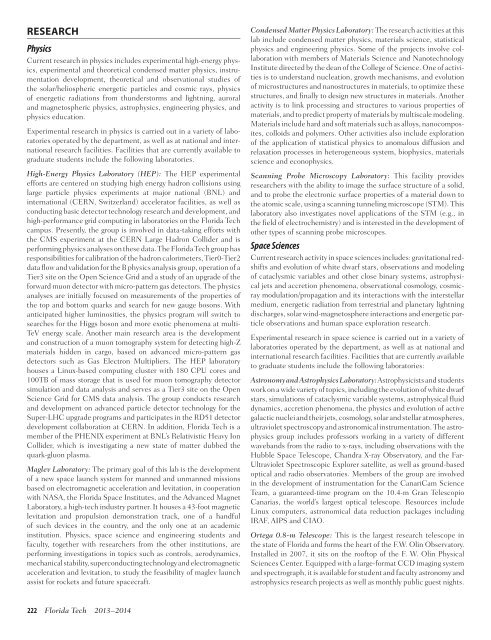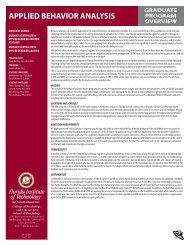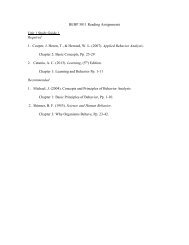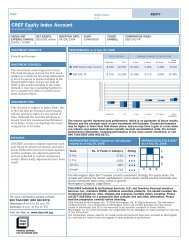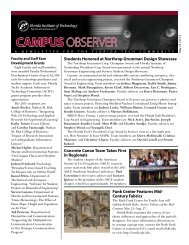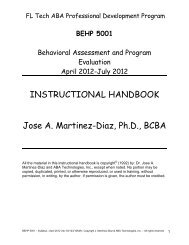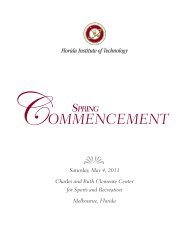2013–2014 UNIVERSITY CATALOG - Florida Institute of Technology
2013–2014 UNIVERSITY CATALOG - Florida Institute of Technology
2013–2014 UNIVERSITY CATALOG - Florida Institute of Technology
You also want an ePaper? Increase the reach of your titles
YUMPU automatically turns print PDFs into web optimized ePapers that Google loves.
RESEARCH<br />
Physics<br />
Current research in physics includes experimental high-energy physics,<br />
experimental and theoretical condensed matter physics, instrumentation<br />
development, theoretical and observational studies <strong>of</strong><br />
the solar/heliospheric energetic particles and cosmic rays, physics<br />
<strong>of</strong> energetic radiations from thunderstorms and lightning, auroral<br />
and magnetospheric physics, astrophysics, engineering physics, and<br />
physics education.<br />
Experimental research in physics is carried out in a variety <strong>of</strong> laboratories<br />
operated by the department, as well as at national and international<br />
research facilities. Facilities that are currently available to<br />
graduate students include the following laboratories.<br />
High-Energy Physics Laboratory (HEP): The HEP experimental<br />
efforts are centered on studying high energy hadron collisions using<br />
large particle physics experiments at major national (BNL) and<br />
international (CERN, Switzerland) accelerator facilities, as well as<br />
conducting basic detector technology research and development, and<br />
high-performance grid computing in laboratories on the <strong>Florida</strong> Tech<br />
campus. Presently, the group is involved in data-taking efforts with<br />
the CMS experiment at the CERN Large Hadron Collider and is<br />
performing physics analyses on these data. The <strong>Florida</strong> Tech group has<br />
responsibilities for calibration <strong>of</strong> the hadron calorimeters, Tier0-Tier2<br />
data flow and validation for the B physics analysis group, operation <strong>of</strong> a<br />
Tier3 site on the Open Science Grid and a study <strong>of</strong> an upgrade <strong>of</strong> the<br />
forward muon detector with micro-pattern gas detectors. The physics<br />
analyses are initially focused on measurements <strong>of</strong> the properties <strong>of</strong><br />
the top and bottom quarks and search for new gauge bosons. With<br />
anticipated higher luminosities, the physics program will switch to<br />
searches for the Higgs boson and more exotic phenomena at multi-<br />
TeV energy scale. Another main research area is the development<br />
and construction <strong>of</strong> a muon tomography system for detecting high-Z<br />
materials hidden in cargo, based on advanced micro-pattern gas<br />
detectors such as Gas Electron Multipliers. The HEP laboratory<br />
houses a Linux-based computing cluster with 180 CPU cores and<br />
100TB <strong>of</strong> mass storage that is used for muon tomography detector<br />
simulation and data analysis and serves as a Tier3 site on the Open<br />
Science Grid for CMS data analysis. The group conducts research<br />
and development on advanced particle detector technology for the<br />
Super-LHC upgrade programs and participates in the RD51 detector<br />
development collaboration at CERN. In addition, <strong>Florida</strong> Tech is a<br />
member <strong>of</strong> the PHENIX experiment at BNL’s Relativistic Heavy Ion<br />
Collider, which is investigating a new state <strong>of</strong> matter dubbed the<br />
quark-gluon plasma.<br />
Maglev Laboratory: The primary goal <strong>of</strong> this lab is the development<br />
<strong>of</strong> a new space launch system for manned and unmanned missions<br />
based on electromagnetic acceleration and levitation, in cooperation<br />
with NASA, the <strong>Florida</strong> Space <strong>Institute</strong>s, and the Advanced Magnet<br />
Laboratory, a high-tech industry partner. It houses a 43-foot magnetic<br />
levitation and propulsion demonstration track, one <strong>of</strong> a handful<br />
<strong>of</strong> such devices in the country, and the only one at an academic<br />
institution. Physics, space science and engineering students and<br />
faculty, together with researchers from the other institutions, are<br />
performing investigations in topics such as controls, aerodynamics,<br />
mechanical stability, superconducting technology and electromagnetic<br />
acceleration and levitation, to study the feasibility <strong>of</strong> maglev launch<br />
assist for rockets and future spacecraft.<br />
222 <strong>Florida</strong> Tech <strong>2013–2014</strong><br />
Condensed Matter Physics Laboratory: The research activities at this<br />
lab include condensed matter physics, materials science, statistical<br />
physics and engineering physics. Some <strong>of</strong> the projects involve collaboration<br />
with members <strong>of</strong> Materials Science and Nanotechnology<br />
<strong>Institute</strong> directed by the dean <strong>of</strong> the College <strong>of</strong> Science. One <strong>of</strong> activities<br />
is to understand nucleation, growth mechanisms, and evolution<br />
<strong>of</strong> microstructures and nanostructures in materials, to optimize these<br />
structures, and finally to design new structures in materials. Another<br />
activity is to link processing and structures to various properties <strong>of</strong><br />
materials, and to predict property <strong>of</strong> materials by multiscale modeling.<br />
Materials include hard and s<strong>of</strong>t materials such as alloys, nanocomposites,<br />
colloids and polymers. Other activities also include exploration<br />
<strong>of</strong> the application <strong>of</strong> statistical physics to anomalous diffusion and<br />
relaxation processes in heterogeneous system, biophysics, materials<br />
science and econophysics.<br />
Scanning Probe Microscopy Laboratory: This facility provides<br />
researchers with the ability to image the surface structure <strong>of</strong> a solid,<br />
and to probe the electronic surface properties <strong>of</strong> a material down to<br />
the atomic scale, using a scanning tunneling microscope (STM). This<br />
laboratory also investigates novel applications <strong>of</strong> the STM (e.g., in<br />
the field <strong>of</strong> electrochemistry) and is interested in the development <strong>of</strong><br />
other types <strong>of</strong> scanning probe microscopes.<br />
Space Sciences<br />
Current research activity in space sciences includes: gravitational redshifts<br />
and evolution <strong>of</strong> white dwarf stars, observations and modeling<br />
<strong>of</strong> cataclysmic variables and other close binary systems, astrophysical<br />
jets and accretion phenomena, observational cosmology, cosmicray<br />
modulation/propagation and its interactions with the interstellar<br />
medium, energetic radiation from terrestrial and planetary lightning<br />
discharges, solar wind-magnetosphere interactions and energetic particle<br />
observations and human space exploration research.<br />
Experimental research in space science is carried out in a variety <strong>of</strong><br />
laboratories operated by the department, as well as at national and<br />
international research facilities. Facilities that are currently available<br />
to graduate students include the following laboratories:<br />
Astronomy and Astrophysics Laboratory: Astrophysicists and students<br />
work on a wide variety <strong>of</strong> topics, including the evolution <strong>of</strong> white dwarf<br />
stars, simulations <strong>of</strong> cataclysmic variable systems, astrophysical fluid<br />
dynamics, accretion phenomena, the physics and evolution <strong>of</strong> active<br />
galactic nuclei and their jets, cosmology, solar and stellar atmospheres,<br />
ultraviolet spectroscopy and astronomical instrumentation. The astrophysics<br />
group includes pr<strong>of</strong>essors working in a variety <strong>of</strong> different<br />
wavebands from the radio to x-rays, including observations with the<br />
Hubble Space Telescope, Chandra X-ray Observatory, and the Far-<br />
Ultraviolet Spectroscopic Explorer satellite, as well as ground-based<br />
optical and radio observatories. Members <strong>of</strong> the group are involved<br />
in the development <strong>of</strong> instrumentation for the CanariCam Science<br />
Team, a guaranteed-time program on the 10.4-m Gran Telescopio<br />
Canarias, the world’s largest optical telescope. Resources include<br />
Linux computers, astronomical data reduction packages including<br />
IRAF, AIPS and CIAO.<br />
Ortega 0.8-m Telescope: This is the largest research telescope in<br />
the state <strong>of</strong> <strong>Florida</strong> and forms the heart <strong>of</strong> the F.W. Olin Observatory.<br />
Installed in 2007, it sits on the ro<strong>of</strong>top <strong>of</strong> the F. W. Olin Physical<br />
Sciences Center. Equipped with a large-format CCD imaging system<br />
and spectrograph, it is available for student and faculty astronomy and<br />
astrophysics research projects as well as monthly public guest nights.


